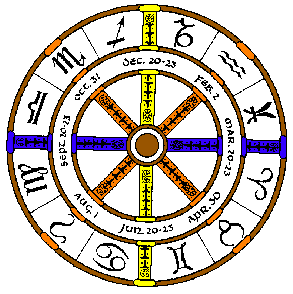THE YEAR OF THE SUN: NATURE AND GERMANIC CULTURE
Midwinter Solstice December 21
Sonnwend, Rauhnächte
Dec. 24 - Birth of Christ/Christmas |
Cross Quarter
Nov. 1 - Halloween
All Saints/All Souls | Cross Quarter
Feb. 2 -
Groundhog / Candlemas |
Autumnal Equinox
September 22
Harvest Home* |

|
Vernal Equinox
March 20
Easter** |
Cross Quarter
Aug. 1 - First Harvest
Markets / Fairs |
Cross Quarter
April 30 - Walpurgis/Mayfest
Maifest/Mayday |
Midsummer Solstice June 20
June 24 - Sonnwend, Midsummer Night
Johannistag/Birthday of St. John the Baptist |
*Harvest Moon - Full moon nearest Autumnal Equinox (harvest,
ves, corn, grapes, pumpkins)
**1st full moon after Vernal Equinox (birth/rebirth, fertility: eggs, chicks, Easter bunny, lambs)
Solstices (yellow) are solar celebrations, Equinoxes (blue) are lunar celebrations
THE JULIAN AND THE GREGORIAN CALENDAR
The problem, plaguing the calendar year, has consistently been the
fact that the actual length of the year is 365.2422 days. The Julian
calendar was established by Julius Caesar in 46 B.C. and was in use up
to 1582. It had 12 months with 365 days in the year for three years and
a leap year of 366 days, based on one year equaling 365.25 days. By 1582,
the calendar had lost 10 days--the vernal equinox had moved from March 21
to March 10. In 1582, Pope Gregory XIII revised the calendar. The day after
October 5, 1582 would be October 15, 1582 and century years not divisible
evenly by 400 would no longer be counted as leap years.
In Christian nations under the Julian calendar New Years Day was
observed on March 25. The Gregorian calendar changed New Years Day to
January 1. The Gregorian calendar was adopted by German Catholic areas
in 1583-1585, but was not accepted in Protestant areas until much later.
In great Britain and America, the Gregorian calendar was initiated on
January 1, 1753.
Julian Date Converter and Information
A discussion of the calendar and Pope Gregory's reforms from the Catholic Encyclopedia.
Further links to Calendars and related websites.
Time Line of Religious Beliefs
| ~500 AD | -/---------/- | ~1500 AD |
| Pagan/Germanic | Christian | Catholic - Protestant |
Culture = beliefs, customs and traditions held by a group
Ruth Reichmann
Max Kade German-American Center
Indiana Univ.-Purdue Univ. Indianapolis
Return to Customs Page
